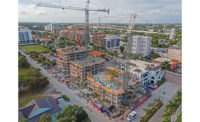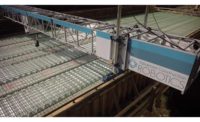In one shift May 12, the TyBot robot tied 11,044 rebar intersections on a job site in Florida, setting a 2022 record.
Advanced Construction Robotics (ACR), based in Pittsburgh, debuted the rebar-tying robot in 2017, and it’s since helped companies like Shelby Erectors save time and manpower.
Jack Nix, chief operating officer at Shelby, says the company was one of the early adopters of TyBot. Shelby has used it on jobsites for two and a half years, including on the Florida Dept. of Transportation’s Gateway Expressway project near Tampa, where TyBot set the 2022 record.
Nix says TyBot, and the soon-to-come rebar-laying IronBot, will change the industry.
“I just think it’s the way of the future,” Nix says. “That 11,000 in one day, that was an accomplishment.”
That type of output is what the company envisioned when it began using the robot, he says.
TyBot set the 2022 record during one 10-hour shift at the Gateway Expressway project, working to construct two new elevated two-lane tolled roadways.
Nix says TyBot usually works in 10-hour shifts, replacing four or five workers who, depending on skill level, can tie 200-300 intersections per hour.
“That machine doesn’t take a water break—doesn’t take any breaks,” he says.
The robot only stops tying rebar when the single robot supervisor has to swap out the 15-lb spools of wire, which happens three or four times per 10-hour shift and takes about 10 minutes.
Now, the challenge is getting contractors to keep up with the 25% to 30% schedule reduction he says Tybot is creating.
“We’re able to move faster than contractors are used to,” Nix says. “Maybe they need 1,000 more feet overhang and screed rail to be able to support the improvement in schedule-that’s the learning curve.”
Danielle Proctor, ACR CEO, says contractors tell ACR that the most valuable thing about TyBot is the ability to rely on that schedule gain and enhance crews by dedicating those workers who would be tying rebar to more critical-path items.
“The number-one thing is alleviating mundane, backbreaking, repetitive tasks so that they can go do stuff that needs to get done,” she says.
Nix emphasizes the work his robot is saving his crews, noting temperatures in Florida that can top 100°F before adding in the humidity and sun.
“I did this work in the field and that’s the hardest thing to do," he says. "You’re bent over, tying at your feet. It just hurts. You can’t stay bent over that long.”
Those workers can now be carrying and framing out steel instead, he adds.
So far, TyBots have completed more than 33 projects across nine states and just under 3 million individual ties, Proctor says. In a 40-hour week, the robot can complete roughly 36,000 ties.
ACR has also shifted from a leasing and sale model to offering the robots as a service, with a usage-based pricing model, charging per tie.
“If it completes a tie, you pay for it,” Proctor says, a price that includes having the unit configured for the project, the wire, unlimited remote service, support and maintenance as well as all pre-deployment support.
A rule of thumb is that customers see a return on investment using the robot on jobs that are 20,000 sq ft or greater, she says. Above that, the robot gets more and more attractive.
Nix says his firm is still working with ACR on figuring out the best price, as it only makes sense if it costs him less than it would to pay workers to do it manually, noting that that price can vary from place to place depending on wages.
Up next from ACR is the IronBot, which Nix says Shelby is hoping to put in practice as soon as possible.
IronBot, which would lay down rebar ahead of the TyBot, should hit the market in the next six to eight weeks, and is on a maiden voyage to an as-yet undisclosed job site, Proctor says.
“We’ll be an early adopter of that,” Nix says, which he estimates could free up another two or three workers.
With both robots operating, he expects it to really help with ongoing labor issues, doubling production or better.
Proctor says that in operation with two TyBots that would be needed to keep up with the IronBot, subcontractors like Shelby could see anywhere between 250% to 460% increases in productivity.
IronBot will be able to lift, carry and self-place up to 5,000-lb bundles of both transverse and longitudinal rebar, and will be able to change its direction, she says.
“It’s going to be a game-changer, an absolute game-changer,” Proctor says.






Post a comment to this article
Report Abusive Comment